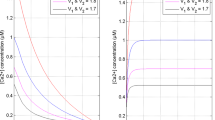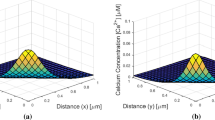Abstract
The study of calcium ([Ca2+]) and dopamine (DA) as independent signaling systems generated limited information on each of these complex adaptive systems. Recently, an integer-order model of these two complex adaptive systems gave better insights into different regulatory mechanisms. However, these integer-order systems cannot generate information regarding the superdiffusion and memory with Brownian motion (BM) mechanisms. Also, the superdiffusion and memory triggering BM of [Ca2+] and dopamine signaling have not been investigated so far in neurons. Here, a fractional-order mathematical framework is proposed to investigate the nonlinear spatiotemporal interactive and adaptive system dynamics of [Ca2+] and dopamine in neurons. The fractional reaction–diffusion equations for [Ca2+] and dopamine with one-way feedback are incorporated in the present framework. The Crank–Nicholson (CN) procedure along with the Grunwald estimation concerning spatial derivatives and the L1 formula concerning temporal derivatives with Gauss–Seidel (GS) iterations have been utilized for numerical simulation. The novel information on the functioning of different mechanisms of [Ca2+] and DA in neurons due to the memory effects causing BM and superdiffusion has been obtained from numerical results. The proposed simulation approach is quite effective in generating the conditions causing the alterations in [Ca2+] and dopamine levels, which may result in neurological illnesses like Parkinson’s disease (PD), etc.









Similar content being viewed by others
Data availability
Data sharing is not applicable to this article as no datasets were generated or analyzed during the current study.
References
E. Binder, B. Kinkead, M. Owens, C.B. Nemeroff, Neurotensin and dopamine interactions. Pharmacol. Rev. 53, 453–486 (2001)
H. Yuan, J.C. Zheng, P. Liu, S.F. Zhang, J.Y. Xu, L.M. Bai, Pathogenesis of Parkinson’s disease: oxidative stress, environmental impact factors and inflammatory processes. Neurosci. Bull. 23, 125–130 (2007). https://doi.org/10.1007/s12264-007-0018-x
A.H. Stokes, T.G. Hastings, K.E. Vrana, Cytotoxic and genotoxic potential of dopamine. J. Neurosci. Res. 55, 659–665 (1999). https://doi.org/10.1002/(SICI)1097-4547(19990315)55:6%3c659::AID-JNR1%3e3.0.CO;2-C
Z. Qi, G.W. Miller, E.O. Voit, Mathematical models of dopamine metabolism in parkinson’s disease. Syst. Biol. Park Dis (2012). https://doi.org/10.1007/978-1-4614-3411-5_8
A.L. Fogelson, R.S. Zucker, Presynaptic calcium diffusion from various arrays of single channels implications for transmitter release and synaptic facilitation. Biophys. J. 48, 1003–1017 (1985). https://doi.org/10.1016/S0006-3495(85)83863-7
J. Wagner, J. Keizer, Effects of rapid buffers on Ca2+ diffusion and Ca2+ oscillations. Biophys. J. 67, 447–456 (1994). https://doi.org/10.1016/S0006-3495(94)80500-4
A. Verkhratsky, The endoplasmic reticulum and neuronal calcium signalling. Cell Calcium 32, 393–404 (2002). https://doi.org/10.1016/S0143416002001896
J. Sneyd, S. Girard, D. Clapham, Calcium wave propagation by calcium-induced calcium release: an unusual excitable system. Bull. Math. Biol. (1993). https://doi.org/10.1016/S0092-8240(05)80268-X
M. Brini, T. Calì, D. Ottolini, E. Carafoli, Neuronal calcium signaling: function and dysfunction. Cell. Mol. Life Sci. 71, 2787–2814 (2014). https://doi.org/10.1007/s00018-013-1550-7
B.K. Jha, N. Adlakha, M.N. Mehta, Two-dimensional finite element model to study calcium distribution in astrocytes in presence of excess buffer. Int. J. Biomath. 7, 1–11 (2014). https://doi.org/10.1142/S1793524514500314
Y. Jagtap, N. Adlakha, Numerical model of hepatic glycogen phosphorylase regulation by nonlinear interdependent dynamics of calcium and IP3. Eur. Phys. J. Plus. 138, 1–13 (2023). https://doi.org/10.1140/epjp/s13360-023-03961-y
V. Mishra, N. Adlakha, Numerical simulation of calcium dynamics dependent ATP degradation, IP3 and NADH production due to obesity in a hepatocyte cell. J. Biol. Phys. (2023). https://doi.org/10.1007/s10867-023-09639-x
V. Mishra, N. Adlakha, Spatio temporal interdependent calcium and buffer dynamics regulating DAG in a hepatocyte cell due to obesity. J. Bioenerg. Biomembr. (2023). https://doi.org/10.1007/s10863-023-09973-8
N. Manhas, K.R. Pardasani, Mathematical model to study IP3 Dynamics dependent calcium oscillations in pancreatic acinar cells. J. Med. Imag. Heal. Inform. 4, 874–880 (2014). https://doi.org/10.1166/jmihi.2014.1333
N. Manhas, K.R. Pardasani, Modelling mechanism of calcium oscillations in pancreatic acinar cells. J. Bioenerg. Biomembr. 46, 403–420 (2014). https://doi.org/10.1007/s10863-014-9561-0
K. Pathak, N. Adlakha, Finite element simulation of advection diffusion of calcium in myocyes involving influx and excess buffer. Adv. Comput. Sci. Technol. 10, 11–23 (2017)
N. Singh, N. Adlakha, Nonlinear dynamic modeling of 2-dimensional interdependent calcium and inositol 1,4,5-trisphosphate in cardiac myocyte. Math. Biol. Bioinform. 14, 290–305 (2019). https://doi.org/10.17537/2019.14.290
N. Singh, N. Adlakha, Three dimensional coupled reaction-diffusion modeling of calcium and inositol 1,4,5-trisphosphate dynamics in cardiomyocytes. RSC Adv. 9, 42459–42469 (2019). https://doi.org/10.1039/c9ra06929a
M. Kotwani, N. Adlakha, M.N. Mehta, Finite element model to study calcium diffusion with excess buffer approximation in fibroblast cell. Int. J. Comput. Appl. Math. 7, 503–514 (2012)
A.B. Kothiya, N. Adlakha, Cellular nitric oxide synthesis is affected by disorders in the interdependent Ca2+ and IP3 dynamics during cystic fibrosis disease. J. Biol. Phys. 49, 133–158 (2023). https://doi.org/10.1007/s10867-022-09624-w
A.B. Kothiya, N. Adlakha, Simulation of biochemical dynamics of Ca2+ and PLC in fibroblast cell. J. Bioenerg. Biomembr. (2023). https://doi.org/10.1007/s10863-023-09976-5
V. Tewari, S. Tewari, K.R. Pardasani, A model to study the effect of excess buffers and Na + ions on Ca 2+ diffusion in neuron cell. World Acad. Sci. Eng. Technol. 76, 41–46 (2011). https://doi.org/10.5281/zenodo.1054988
S.G. Tewari, K.R. Pardasani, Modeling effect of sodium pump on calcium oscillations in neuron cells. J. Multiscale Model. 04, 1250010 (2012). https://doi.org/10.1142/s1756973712500102
H. Bhardwaj, N. Adlakha, Radial basis function based differential quadrature approach to study reaction diffusion of Ca2+ in T lymphocyte. Int. J. Comput. Methods (2022). https://doi.org/10.1142/S0219876222500591
H. Bhardwaj, N. Adlakha, Model to study interdependent calcium and IP3 distribution regulating NFAT production in T lymphocyte. J. Mech. Med. Biol. (2023). https://doi.org/10.1142/S0219519423500550
P.A. Naik, Modeling the mechanics of calcium regulation in T lymphocyte: a finite element method approach. Int J Biomath (2020). https://doi.org/10.1142/S1793524520500382
P.A. Naik, K.R. Pardasani, One dimensional finite element method approach to study effect of ryanodine receptor and serca pump on calcium distribution in oocytes. J. Multiscale Model. 05, 1350007 (2013). https://doi.org/10.1142/S1756973713500078
P.A. Naik, K.R. Pardasani, 2D finite-element analysis of calcium distribution in oocytes. Netw. Model. Anal. Heal. Inform. Bioinform. 7, 1–11 (2018). https://doi.org/10.1007/s13721-018-0172-2
N.A. Vaishali, Disturbances in system dynamics of Ca2+ and IP3 perturbing insulin secretion in a pancreatic β -cell due to type-2 diabetes. J. Bioenerg. Biomembr. (2023). https://doi.org/10.1007/s10863-023-09966-73
A. Tripathi, N. Adlakha, Finite element model to study calcium diffusion in a neuron cell involving jryr, jserca and jleak. J. Appl. Math. Inform 31, 695–709 (2013). https://doi.org/10.14317/jami.2013.695
D.D. Dave, B.K. Jha, Analytically depicting the calcium diffusion for Alzheimer’s affected cell. Int. J. Biomath. 11, 1–13 (2018). https://doi.org/10.1142/S1793524518500882
G.W. Zamponi, J. Striessnig, A. Koschak, A.C. Dolphin, The physiology, pathology, and pharmacology of voltage-gated calcium channels and their future therapeutic potential. Pharmacol. Rev. 67, 821–870 (2015). https://doi.org/10.1124/pr.114.009654
M.E. Soden, G.L. Jones, C.A. Sanford, A.S. Chung, A.D. Güler, C. Chavkin, R. Luján, L.S. Zweifel, Disruption of dopamine neuron activity pattern regulation through selective expression of a human KCNN3 mutation. Neuron 80, 997–1009 (2013). https://doi.org/10.1016/j.neuron.2013.07.044
L.A. Sombers, M. Beyene, R.M. Carelli, R.M. Wightman, Synaptic overflow of dopamine in the nucleus accumbens arises from neuronal activity in the ventral tegmental area. J. Neurosci. 29, 1735–1742 (2009). https://doi.org/10.1523/JNEUROSCI.5562-08.2009
E.V. Mosharov, K.E. Larsen, E. Kanter, K.A. Phillips, K. Wilson, Y. Schmitz, D.E. Krantz, K. Kobayashi, R.H. Edwards, D. Sulzer, Article interplay between cytosolic dopamine, calcium, and a -synuclein causes selective death of substantia Nigra neurons. Neuron 62, 218–229 (2009). https://doi.org/10.1016/j.neuron.2009.01.033
M.K. Sanghera, J. Zamora, D.C. German, Calbindin-D 28k - containing Neurons in the Human hypothalamus: relationship to dopaminergic. Neurons 4, 375–381 (1995)
T. Yamada, P.L. Mcgeer, K.G. Baimbridge, E.G. Mcgeer, Relative sparing in Parkinson ’ s disease of substantia Nigra dopamine neurons containing calbindin-D2sK. Stem Cell Reports 526, 303–307 (1990)
Y. Tabata, Y. Imaizumi, M. Sugawara, T. Andoh-Noda, S. Banno, M.C. Chai, T. Sone, K. Yamazaki, M. Ito, K. Tsukahara, H. Saya, N. Hattori, J. Kohyama, H. Okano, T-type calcium channels determine the vulnerability of dopaminergic neurons to mitochondrial stress in familial parkinson disease. Stem Cell Reports 11, 1171–1184 (2018). https://doi.org/10.1016/j.stemcr.2018.09.006
A. Mcmahon, B.S. Wong, A.M. Iacopino, M.C. Ng, S. Chi, D.C. German, Calbindin-D 28k buffers intracellular calcium and promotes resistance to degeneration in PC12 cells. Mole. Brain Res. 54(1), 56–63 (1998)
A. Pawar, K.R. Pardasani, Computational model of calcium dynamics-dependent dopamine regulation and dysregulation in a dopaminergic neuron cell. Eur. Phys. J. Plus. 123, 1–19 (2023). https://doi.org/10.1140/epjp/s13360-023-03691-1
A. Pawar, K.R. Pardasani, Effects of disorders in interdependent calcium and IP3 dynamics on nitric oxide production in a neuron cell. Eur. Phys. J. Plus. 137, 543 (2022). https://doi.org/10.1140/EPJP/S13360-022-02743-2
A. Pawar, Effect of disturbances in neuronal calcium and IP3 dynamics on b -amyloid production and degradation. Cogn. Neurodyn. (2022). https://doi.org/10.1007/s11571-022-09815-0
A. Pawar, K.R. Pardasani, Mechanistic insights of neuronal calcium and IP 3 signaling system regulating ATP release during ischemia in progression of Alzheimer ’ s disease. Eur. Biophys. J. (2023). https://doi.org/10.1007/s00249-023-01660-1
A. Pawar, K.R. Pardasani, Computational model of interacting system dynamics of calcium, IP 3 and β -amyloid in ischemic neuron cells. Phys. Scr. 99, 15025 (2024). https://doi.org/10.1088/1402-4896/ad16b5
A. Pawar, K.R. Pardasani, Modelling cross talk in the spatiotemporal system dynamics of calcium, IP3 and nitric oxide in neuron cells. Cell Biochem. Biophys. (2024). https://doi.org/10.1007/s12013-024-01229-5
R.L. Magin, Fractional calculus models of complex dynamics in biological tissues. Comput. Math. with Appl. 59, 1586–1593 (2010). https://doi.org/10.1016/j.camwa.2009.08.039
M.M. Meerschaert, C. Tadjeran, Finite difference approximations for fractional advection-dispersion flow equations. J. Comput. Appl. Math. 172, 65–77 (2004). https://doi.org/10.1016/j.cam.2004.01.033
I. Podlubny, A. Chechkin, T. Skovranek, Y.Q. Chen, B.M. Vinagre Jara, Matrix approach to discrete fractional calculus II: partial fractional differential equations. J. Comput. Phys. 228, 3137–3153 (2009). https://doi.org/10.1016/j.jcp.2009.01.014
L.C. Cardoso, F.L.P. Dos Santos, R.F. Camargo, Analysis of fractional-order models for hepatitis B. Comput. Appl. Math. 37, 4570–4586 (2018). https://doi.org/10.1007/s40314-018-0588-4
M. Du, Z. Wang, H. Hu, Measuring memory with the order of fractional derivative. Sci. Rep. (2013). https://doi.org/10.1038/srep03431
H. Joshi, B.K. Jha, On a reaction–diffusion model for calcium dynamics in neurons with Mittag-Leffler memory. Eur. Phys. J. Plus (2021). https://doi.org/10.1140/epjp/s13360-021-01610-w
H. Joshi, B.K. Jha, Fractionally delineate the neuroprotective function of calbindin- D 2 8 k in Parkinson’s disease. Int. J. Biomath. 11, 1–19 (2018). https://doi.org/10.1142/S1793524518501036
M.A. Ezzat, A.S.E. Karamany, Fractional order heat conduction law in magneto-thermoelasticity involving two temperatures. Zeitschrift fur Angew. Math. und Phys. 62, 937–952 (2011). https://doi.org/10.1007/s00033-011-0126-3
E. Sousa, Finite difference approximations for a fractional advection diffusion problem. J. Comput. Phys. 228, 4038–4054 (2009). https://doi.org/10.1016/j.jcp.2009.02.011
A. Pawar, K.R. Pardasani, Fractional order interdependent nonlinear chaotic spatiotemporal calcium and Aβ dynamics in a neuron cell. Phys. Scr. (2023). https://doi.org/10.1088/1402-4896/ace1b2
A. Pawar, K.R. Pardasani, Fractional-order reaction – diffusion model to study the dysregulatory impacts of superdiffusion and memory on neuronal calcium and IP3 dynamics. Eur. Phys. J. Plus (2023). https://doi.org/10.1140/epjp/s13360-023-04410-6
A. Pawar, K.R. Pardasani, Nonlinear system dynamics of calcium and nitric oxide due to cell memory and superdiffusion in neurons. Commun. Theor. Phys. (2024). https://doi.org/10.1088/1572-9494/ad35b4
J. Wagner, C.F. Fall, F. Hong, C.E. Sims, N.L. Allbritton, R.A. Fontanilla, I.I. Moraru, L.M. Loew, R. Nuccitelli, A wave of IP3 production accompanies the fertilization Ca2+ wave in the egg of the frog, Xenopus laevis: theoretical and experimental support. Cell Calcium 35, 433–447 (2004). https://doi.org/10.1016/j.ceca.2003.10.009
D. Tello-Bravo, A mathematical model of dopamine neurotransmission. Gastron. Ecuatoriana y Tur. local. 1, 5–24 (1967)
G.D. Smith, Analytical steady-state solution to the rapid buffering approximation near an open Ca2+ channel. Biophys. J. 71, 3064–3072 (1996). https://doi.org/10.1016/S0006-3495(96)79500-0
S.H. Walters, I.M. Taylor, Z. Shu, A.C. Michael, A novel restricted diffusion model of evoked dopamine. ACS Chem. Neurosci. 5, 776–783 (2014). https://doi.org/10.1021/cn5000666
C. Tadjeran, M.M. Meerschaert, H.P. Scheffler, A second-order accurate numerical approximation for the fractional diffusion equation. J. Comput. Phys. 213, 205–213 (2006). https://doi.org/10.1016/j.jcp.2005.08.008
Oldham, K., Spanier, J.: The fractional calculus theory and applications of differentiation and integration to arbitrary order. Academic Press, INC. (London) LTD. (1974)
Author information
Authors and Affiliations
Contributions
Authors have made equitable contributions to the present work concerning problem design and solution, data correction, literature examination, as well as interpretation of the results. Author (1) created the MATLAB code.
Corresponding author
Rights and permissions
Springer Nature or its licensor (e.g. a society or other partner) holds exclusive rights to this article under a publishing agreement with the author(s) or other rightsholder(s); author self-archiving of the accepted manuscript version of this article is solely governed by the terms of such publishing agreement and applicable law.
About this article
Cite this article
Pawar, A., Pardasani, K.R. Simulation of nonlinear system dynamics of calcium and dopamine signaling in neurons. Eur. Phys. J. Plus 139, 390 (2024). https://doi.org/10.1140/epjp/s13360-024-05206-y
Received:
Accepted:
Published:
DOI: https://doi.org/10.1140/epjp/s13360-024-05206-y




